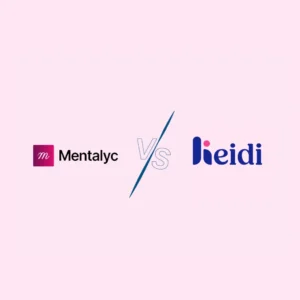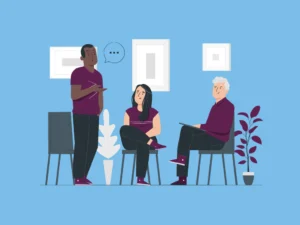In mental healthcare, understanding the difference between process and content is essential when conducting effective therapy. This article explains what these terms mean and why they matter in different therapeutic settings. Practical examples demonstrate how process and content work in practice.
Understanding Content and Process
Content and process, while interrelated, serve different purposes, and require distinct therapeutic approaches.
Content in Therapy
Content is the subject matter discussed in therapy—the specific issues, stories, thoughts, and emotions that clients bring to the sessions. Content may include the narrative details of their experiences, an explanation of the problems they face, or an exploration of expressed emotions. Content is the "what" of the conversation, including:
Concrete experiences and events.
Thoughts and beliefs, or the “cognitive” aspects of the client's narrative (perceptions, interpretations, and beliefs about themselves, others, and the world).
Emotional responses and affective states.
Problems, concerns, and challenges the client identifies as areas of focus (e.g., relationship difficulties, stress, or mental health symptoms).
Understanding the content allows therapists to grasp the client's perspective and the context of their struggles. However, it’s important to note that focusing solely on content can limit the depth of therapeutic work.
Process in Therapy
Process is the "how" of the therapy—the dynamics of the therapeutic relationship, the interactions between therapist and client, and the underlying emotional currents that influence these interactions. Process includes:
Nonverbal communication, such as body language, facial expressions, eye contact, and tone of voice.
Patterns of interaction, or the recurring ways in which clients interact with the therapist and others (e.g., how they respond to questions, express emotions, and engage in therapy).
The overall emotional and relational climate of the therapy session, including trust, safety, and openness.
The underlying emotional dynamics that influence the client's behavior and interactions.
Process is how content is explored and understood by the therapist. Therapists can:
Identify patterns and recognize recurring themes and behaviors that may not be immediately evident in the content.
Help clients become more aware of their emotional responses and interactional patterns. Increased awareness can facilitate personal growth and change.
Foster a deeper connection and trust by addressing relational dynamics and creating a safe space for exploration.
Guide clients in understanding their feelings, thoughts, and behaviors.
By navigating between content and process, therapists can create a more holistic and impactful therapeutic experience, cultivating greater self-awareness, emotional healing, and personal growth in their clients.
Content and Process in Psychology Continue…
Content and process together form a comprehensive framework that enables therapists to understand and address their clients' problems. While content provides the material for discussion, process offers insights into how clients relate to themselves, others, and the therapist. Addressing process reveals deeper issues that may not be immediately apparent through content alone.
Content in psychology refers to the explicit subject matter that clients discuss in-session and includes:
Narrative Details. Clients recount details of life events, experiences, and specific situations, such as a recent job loss or a death in the family.
Cognitive Elements. Thoughts, beliefs, and perceptions, including self-talk and cognitive distortions.
Emotional Experiences. Feelings and emotional states, such as grief, happiness, overwhelm, or fear.
Behavioral Issues. Specific behaviors and actions such as habits, unhealthy coping mechanisms, or risky choices.
Content forms the foundation of the client's presenting problems and provides concrete information.
Process in psychology refers to the underlying dynamics and interactions that occur during therapy sessions and include:
Nonverbal Communication. Posture, facial expressions, eye contact, and tone of voice convey emotions and attitudes not explicitly stated.
Interaction Patterns. Defensiveness, dependency, or hostility may be evident in relational patterns with others.
Therapeutic Relationship. Trust, rapport, and transference dynamics all impact the quality and nature of the relationship between client and therapist.
Emotional Currents. The underlying emotional tone and unspoken feelings.
Process provides insights into how clients relate to themselves, others, and the therapeutic environment.
Importance of Distinguishing Content and Process
Recognizing and addressing both content and process is vital for effective therapeutic interventions. Here are some specific ways.
While content provides surface-level details, process reveals underlying emotional and relational dynamics.
Therapists can help clients become more aware of their emotional responses and interaction patterns.
Process work can lead to greater emotional insight and understanding.
Example: Client who presents with Generalized Anxiety Disorder (GAD)
Content: The client describes feeling anxious and worried about an upcoming trip, detailing the specific things they are afraid of (flying on an airplane, leaving the country, staying in a hotel). The client describes the physical symptoms they experience, such as upset stomach, insomnia, and a rapid heartbeat.
Process: During the session, the client frequently changes the subject when the therapist asks about past trips and vacations. The client exhibits nonverbal signs of discomfort (lack of eye contact, overly brief responses, and fidgeting).
The therapist focuses on process and says, "I notice that when we talk about past travel experiences, you seem to become more anxious and change the topic. Can we talk about what's coming up for you?" This comment allows the client to become aware of their avoidance behavior and opens a deeper exploration.
Content vs. Process in Group Therapy
In group therapy, content and process become complex due to the presence of multiple participants with diverse backgrounds, issues, and personalities. Group members share their stories (content), but the group's dynamics (process) influence the therapeutic experience. Understanding and managing these dynamics is essential for success.
Content in Group Therapy
Content refers to the specific issues, experiences, thoughts, and emotions that each group member brings to the session, including:
Detailed accounts of each member's life events and experiences, such as struggles with addiction, relationship issues, or mental health challenges.
Feelings and emotions that members share with the group, such as grief, rage, disappointment, or terror.
Thoughts, beliefs, and perceptions that members discuss, including their views about themselves, others, and their situations.
Behaviors and actions members describe, such as recovery strategies, coping skills, or unhealthy habits.
An example of content in group therapy: A member shares their recent visit to a casino to gamble, detailing the triggers, thoughts, and emotions they experienced when they relapsed (content).
Process in Group Therapy
Process involves the underlying dynamics and interactions within the group, including:
How group members communicate with each other, including turn-taking, interruptions, and support or criticism.
Roles that members take on within the group, such as the leader, the peacemaker, the critic, or the silent observer.
Overall emotional atmosphere of the group, including trust, safety, tension, and support.
Body language, facial expressions, and other nonverbal signals that indicate feelings and reactions.
The sense of solidarity and connection among group members, which affects the group's effectiveness.
An example of process in group therapy: A member who rarely contributes might be exhibiting a need for control (process). This behavior impacts the group dynamics when other members vulnerably share while learning very little from the non-contributing member.
The group facilitator must recognize and address process in group therapy for several reasons:
1. By addressing process issues, the group facilitator can cultivate a more balanced and inclusive environment for strengthened group cohesion—allowing all members to feel valued and heard. 2. 3. Deeper issues are revealed that are not immediately apparent through content alone. For example, a member's tendency to criticize others (process) might be associated with their feelings of inadequacy. 4. 5. Members gain insights into their interaction patterns and relational dynamics, promoting self-awareness and personal growth. 6. 7. Members develop healthier communication patterns. For example, the facilitator helps a member who frequently interrupts others (process) to learn active listening and patience. 8.
Example: Dominant Member in a Substance Abuse Group
Content: The member tends to overshare, offering rambling accounts of family conflict and challenges at work.
Process: The member's dominance might stem from a lack of awareness, a need for control, or a fear of being ignored. This behavior impacts the group by preventing other members from sharing their own experiences and receiving support.
The group facilitator focuses on process and says, "I've noticed that you take up a lot of space in our discussions. Can we talk about what might be driving this desire to overshare and how it affects the group?" This comment allows the rambling group member to reflect on their behavior and encourages more balanced participation from all group members.
By skillfully addressing both content and process, group facilitators can enhance group cohesion, uncover deeper issues, and promote meaningful change for all group members. Recognizing and managing content and process is essential for creating a supportive and effective therapeutic environment where every member thrives.
Content vs. Process in Family Therapy
The goal of family therapy is to improve relationships and communication patterns within the family system. While content is the specific issues each family member brings to therapy, process involves the interactional patterns, power dynamics, and emotional responses that characterize family interactions.
Content in Family Therapy
Content includes the explicit issues and topics that family members discuss during sessions, including:
Disagreements and disputes between family members, such as marital conflicts, sibling rivalries, or intergenerational tensions.
Issues related to raising children, such as discipline, educational concerns, and differing parenting styles.
Specific behaviors such as a child’s acting out or a family member’s substance use.
Adjustments to significant changes, such as death, divorce, remarriage, or relocation.
Individual emotional issues that affect the family, such as depression or anxiety.
An example of content in family therapy: The family schedules a session to address their teenager’s declining academic performance and increased defiance (content).
Process in Family Therapy
Process involves the underlying dynamics that influence how family members interact and communicate, including:
Recurring ways in which family members communicate and respond to each other, such as yelling, blaming, or interrupting.
The distribution of power and control, including who makes decisions, who dominates conversations, and how authority is exercised.
The emotional reactions and underlying feelings that influence interactions, such as fear or resentment.
Body language, facial expressions, and other nonverbal cues.
The roles each family member assumes within the family, such as the caretaker, the scapegoat, or the mediator.
An example of process in family therapy: As family members discuss their teen’s acting out, they are blaming and defensive. The parents blame the teenager for the family’s problems, while the teen responds with defensiveness and withdrawal (process).
The therapist must recognize and address process in family therapy for several reasons:
1. Recognizing and addressing toxic or dysfunctional interactional patterns can help the family understand how their communication styles contribute to their problems. 2. 3. Process work can improve communication by helping family members develop healthier ways of interacting. 4. 5. Addressing power imbalances can create a more equitable family environment. 6. 7. Family members may become more aware of their emotional responses and underlying feelings, leading to greater empathy and understanding. 8.
Example: Teenager’s Acting Out
Content: The family discusses the teen’s recent drop in grades and increased defiance. The parents express concern and frustration, while the teen feels misunderstood and unfairly blamed.
Process: The therapist observes the parents frequently interrupting each other and their children. Both parents have accusatory tones and roll their eyes. The teen responds with defensiveness, crossing his arms and avoiding eye contact.
The therapist might say, “I notice that when we talk about your son’s acting out and academic problems, there’s frequent interrupting, eye-rolling, and blaming. How do you think this impacts our conversation and your ability to find solutions together?” This intervention highlights interactional patterns and invites the family to reflect on and change their communication style.
By skillfully addressing both content and process, therapists can help families develop healthier communication patterns, balance power dynamics, and enhance emotional understanding, leading to more effective problem-solving and stronger family relationships.
Content vs. Process in Psychodynamic Therapy
Psychodynamic therapy focuses on exploring the unconscious processes that influence a client’s behavior and emotions. This approach emphasizes the interplay between content and process, both of which are vital for understanding and resolving deep-seated psychological issues.
Content in Psychodynamic Therapy
Content involves the explicit material that clients bring into the sessions, including:
Recollections and memories of past experiences, particularly from childhood, may be significant in understanding current behaviors and emotions.
Narratives of dreams, which are considered windows into the unconscious mind, reveal hidden desires, fears, and conflicts.
Specific thoughts, daydreams, and fantasies can provide insights into the inner world and unresolved issues.
Stories and descriptions of significant life events and relationships, including those with parents, siblings, employers, romantic partners, and other influential figures.
An example of content in psychodynamic therapy: A client discusses a recurring dream where they feel trapped in an elevator, detailing the associated vivid imagery and emotions (content).
Process in Psychodynamic Therapy
Process refers to the dynamics that unfold within the therapeutic relationship and the client’s internal experiences during sessions. This includes:
Transference, where a client projects feelings and attitudes from past relationships onto the therapist.
The therapist’s emotional reactions to the client (countertransference) can be influenced by the therapist’s unconscious processes and past experiences.
Behaviors and attitudes that hinder the progress of therapy, such as missed appointments, silence, or changing the subject when discussing painful topics.
The quality of the relationship between therapist and client, including trust, rapport, and collaboration.
An example of process in psychodynamic therapy: While discussing a childhood memory of being attacked by a dog (content), the client shows signs of anxiety and distress, such as fidgeting or hesitating to speak (process).
The therapist must recognize and address process in psychodynamic therapy for several reasons:
1. Revealing unconscious conflicts and emotions that influence current behavior. 2. 3. By exploring transference and countertransference dynamics, therapists can help clients gain insight into their relational patterns and emotional responses. 4. 5. The therapeutic alliance is enhanced by addressing any misunderstandings that arise, fostering a safe and supportive environment for deeper exploration. 6.
Example: Childhood Memory and Process Dynamics
Content: The client describes an incident where they felt humiliated by a teacher in front of the class. They discuss the details of the event, their thoughts at the time, and the long-lasting impact it had on their confidence.
Process: During the session, the therapist notices that the client becomes visibly anxious, avoids eye contact, and pauses frequently. These cues suggest that the memory is still triggering and may be connected to deeper feelings of shame and inadequacy.
The therapist might say, “I notice you seem very anxious as you talk about this memory. Can we explore what feelings are coming up for you right now?” This invites the client to explore their emotional experience, potentially revealing deeper layers of fear and unresolved conflict.
By skillfully addressing both content and process, psychodynamic therapists can facilitate deeper understanding, uncover unconscious conflicts, and promote lasting emotional growth and healing in their clients.
Content and Process Examples
To illustrate the difference between content and process, let’s consider several scenarios:
Individual Therapy
Content: A client discusses their recent job loss, detailing the circumstances and their current financial concerns.
Process: Throughout the session, the client repeatedly downplays their emotions, changes the subject when asked about their feelings, and exhibits nervous behaviors such as fidgeting and avoiding eye contact.
Therapeutic Intervention: The therapist says, "I notice that when we talk about your feelings related to losing your job, you tend to shift the conversation to other topics. Can we explore what might be making it difficult for you to address your emotions?" This addresses the client’s avoidance behavior (process) and invites exploration of their discomfort with vulnerability.
Group Therapy
Content: During a group session, a member frequently interrupts others, sharing lengthy stories about their own experiences.
Process: Frequent interruptions and long-winded stories suggest a need for attention and validation, impacting the group's dynamics as other members feel unheard and marginalized.
Therapeutic Intervention: The facilitator says, "I've noticed that you jump in while others are speaking. How do you think frequent interruptions affect the group?" This question aims to explore the member’s need for attention (process) and its impact on group cohesion and participation.
Family Therapy
Content: Parents discuss their child's academic struggles, detailing concerns about grades and behavior at school.
Process: During the discussion, the parents frequently speak over their child, who remains silent and withdrawn.
Therapeutic Intervention: The therapist says, "I see that you’re not allowing your daughter to share her thoughts and feelings about school. How do you think this affects your ability to communicate as a family?" By highlighting interactional patterns (process), the therapist can address underlying communication issues and cultivate healthier family interactions.
Psychodynamic Therapy
Content: A client discusses a recurring nightmare where they feel buried alive.
Process: As the client describes the nightmare, they exhibit extreme signs of anxiety, such as sweating, shaking, and pausing frequently.
Therapeutic Intervention: The therapist says, "You seem very anxious as you talk about this nightmare. What feelings are coming up for you right now?" This comment addresses the client's emotional response (process) and encourages exploration of the underlying fears and conflicts related to this nightmare.
Couples Therapy
Content: A couple discusses their frequent arguments about household responsibilities, detailing specific incidents where chores were not completed.
Process: The partners exhibit defensive postures, such as crossing arms, using accusatory language, and interrupting each other. They also avoid discussing deeper emotional needs and vulnerabilities.
Therapeutic Intervention: The therapist says, "I notice that when we discuss household responsibilities, there’s a lot of blame and defensiveness. Can we explore what these arguments might actually be about?" This question addresses the defensive communication patterns (process) and invites the couple to explore underlying emotional needs and relational dynamics.
In different therapeutic contexts, distinguishing between content and process is essential when choosing the most effective interventions. By skillfully addressing both content and process, therapists facilitate deeper understanding, uncover unconscious conflicts, and promote meaningful change and growth in their clients. Recognizing and managing these dynamics is critical to creating a trusting, supportive, and effective therapeutic environment.
Examples of Process Comments in Therapy
Process comments are therapeutic interventions that focus on the dynamics of the therapeutic relationship and the client's behavior and reactions in the session. These comments focus on how clients interact, communicate, and respond, providing valuable insights and facilitating deeper self-awareness and therapeutic progress. Here are some examples of process comments in various therapeutic contexts:
Avoidance of Eye Contact in Individual Therapy
Observation: "I’ve observed that when you talk about your father, you avoid making eye contact. What do you think is happening there?"
Purpose: This comment draws attention to nonverbal behavior, encouraging the client to reflect on their emotions and relationship dynamic with their father.
Avoiding Topics in Individual Therapy
Observation: "I notice you often change the subject when we start to discuss your childhood. What do you think might be behind that?"
Purpose: This addresses avoidance behaviors, inviting the client to explore potential anxiety or fear related to discussing past experiences.
Silent Withdrawal in Group Therapy
Observation: "You’ve been very quiet during today's session. What’s going on for you right now?"
Purpose: By addressing the member’s withdrawal, the therapist encourages participation and explores underlying feelings of discomfort or fear.
Dominating Conversations in Group Therapy
Observation: "You often take the lead in discussions. What does it feel like for you when others are sharing?"
Purpose: This comment invites the member to reflect on their behavior and consider the importance of balanced participation.
Parental Blame and Defensiveness in Family Therapy
Observation: "I notice that when discussing your teen's behavior, there’s a lot of blaming and defensiveness. How do you think this affects your ability to work together as a team?"
Purpose: This comment highlights unhealthy communication patterns, encouraging parents to reflect on their interactions and work toward more constructive communication.
Escalating Conflicts in Family Therapy
Observation: "Whenever we discuss household rules, the conversation quickly becomes heated. What do you think contributes to this escalation?"
Purpose: This comment draws attention to the emotional intensity of conflicts, helping the family explore underlying issues and develop more effective ways of resolving disputes.
Defensive Reactions in Couples Therapy
Observation: "I’ve noticed that when your partner brings up certain topics, you become very defensive. Can we explore what’s happening for you in those moments?"
Purpose: This comment addresses defensive behavior, inviting the partner to explore underlying fears or insecurities.
Avoiding Sensitive Topics in Couples Therapy
Observation: "When we talk about intimacy, you both tend to change the subject. What do you think is making this topic difficult to discuss?"
Purpose: This comment highlights avoidance, encouraging the couple to address and work through sensitive issues.
By appropriately addressing the process in therapy, therapists help clients gain insight into their patterns of behavior and emotional responses. Process comments encourage clients to reflect on their interactions, explore underlying issues, and develop greater self-awareness. This approach facilitates deeper therapeutic growth, leading to more meaningful and lasting change. Recognizing and skillfully addressing both content and process is essential for creating a supportive and effective therapeutic environment.
Conclusion
Understanding and addressing both content and process is absolutely critical for effective therapy. While content provides the material for exploration, process offers a window into the underlying dynamics and emotional currents that shape clients’ experiences. By skillfully navigating between content and process, therapists can foster meaningful change and promote healing and recovery in their clients.
Why other mental health professionals love Mentalyc

“It immediately changed my quality of life, personally and professionally. I went from 3–4 hours a week of notes to 1 hour at most … that alone is invaluable personally and professionally.”
Owner/Independently Licensed Marriage & Family Therapist (IMFT)

“Do yourself a favor, make your life easier. Use the tools that are readily available … I found Mentalyc to be one of the best tools that I’ve ever used.”
Licensed Marriage and Family Therapist

“For those who have hesitations … It is a lifesaver. It will change your life and you have more time to be present with your patients.”
Licensed Clinical Social Worker






